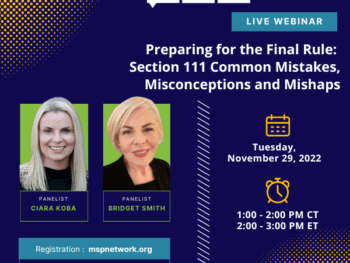
Section 111 Reporting: A Brief Background
Section 111 reporting guidelines and civil monetary penalties find their origin in the Medicare and Medicaid Schip Extension (MMSEA) Act, passed into law and signed by President George W. Bush on December 28, 2007. The law detailed reporting requirements on Non-Group Health Plans (NGHP)[1] in Section 111 of the bill and codified under 42 U.S.C. §1395y(b)(7) and (8). This law requires “mandatory Insurer Reporting requirements on Group Health Plans and Non-Group Health Plans involving a Medicare beneficiary.” Failure to correctly report under Section 111 can result in civil monetary penalties.
Click Link to Access Free PDF Download
A significant change to Section 111 reporting penalties was made in the Strengthening Medicare and Repaying Taxpayers (SMART) Act signed into law by President Obama on January 11, 2013. This law modified the Section 111 reporting guidelines as follows:
- Modified the $1,000 per day/claim penalty to “up to” $1,000 per day/claim; and
- Provided safe harbor for “good faith” efforts in mandatory reporting requirements.
Notwithstanding these changes, the failure of administrative rulemaking delayed the implementation and collection of civil penalties.
Are We There Yet? Anatomy of Regulatory Rulemaking
Many portions of the Section 111 reporting guidelines were intentionally made vague to allow agency rulemaking to define the reporting parameters and collection of civil monetary penalties. This process has been long and drawn out – filled with many starts and stops that have frustrated interested stakeholders:
- December 11, 2013: Medicare Program; Medicare Secondary Payer and Certain Civil Money Penalties – CMS-6061-P. The comment period for this Rule closed on February 10, 2014, but was withdrawn in the summer of 2015; and
- February 18, 2020: Medicare Program; Medicare Secondary Payer and Certain Civil Money Penalties – CMS–6061–P. Rulemaking was launched with various proposals for comment, which closed on April 20, 2023. Interested stakeholders held their breath!
On October 11, 2023, the final rule was published. The big question now is, “So what?!?”
Implementation of the Final Rule
The final rule regarding civil monetary penalties will be effective on December 11, 2023, and enforcement will begin October 11, 2024. Now is the time to ensure your Section 111 processes are reporting correctly and all interested stakeholders know how it impacts workers’ compensation claims and settlements.
- Rule Effective Date: The Rule is effective on December 11, 2023, but “are applicable on or after October 11, 2024.”
FREE DOWNLOAD: “Step-By-Step Process To Master Workers’ Comp In 90 Days”
- Deficiency that Triggers Penalty: A Required Reporting Entity (RRE) “Fails to report any beneficiary record within 1 year from the date of the settlement, judgment, award, or other payment[2], or the effective date where ongoing payment responsibility for medical care[3] has been assumed by the entity.” The Rule includes several insurances where the RRE took action, but information was not completely reported.
- Safe Harbor From Penalties: The Rule provides actions RRE must take not to be sanctioned a civil penalty for failing to report. This includes details required communications via US Mail and other means to obtain the necessary information.
- How Much Can an RRE be Fined: The Rule contains a tiered approach to sanctions depending on the nature and extent of non-reporting and severity. These tiers are as follows:
- $250 – for each calendar day of noncompliance[4] for each individual for which the required information should have been submitted but was reported more than 1 year but less than 2 years after the required reporting date;
- $500 – for each calendar day of noncompliance for each individual for which the required information should have been submitted but was reported 2 years or more, but less than 3 years, after the required reporting date; and
- $1,000 – for each calendar day of noncompliance for each individual for which the required information should have been submitted but was reported 3 years or more after the required reporting date.
These sanctions are to be annually adjusted under 45 CFR part 102. The maximum penalty that may be imposed for noncompliance associated with any one individual for which the required information should have been submitted is $365,000, which is also subject to annual adjustments.
There remain many questions, which will likely be answered in the coming months. Now is the time to prepare to ensure your claim team has the mechanisms and communication in place to ensure accurate, proper, and complete reporting.
Conclusions
The long-awaited Section 111 civil monetary penalties rule is here. Now is the time to educate your claim team and other interested stakeholders. The industry responded well when the MMSEA was first passed. Now is the time to prepare for full implementation and ensure compliance.

Contact: mstack@reduceyourworkerscomp.com.
Workers’ Comp Roundup Blog: http://blog.reduceyourworkerscomp.com/
©2023 Amaxx LLC. All rights reserved under International Copyright Law.
Do not use this information without independent verification. All state laws vary. You should consult with your insurance broker, attorney, or qualified professional.
FREE DOWNLOAD: “Step-By-Step Process To Master Workers’ Comp In 90 Days”
[1] Examples include workers’ compensation, no-fault, and general liability insurance plans.
[2] Total Payment Obligation to Claimant (TPOC)
[3] Ongoing Responsibility for Medical (ORM)
[4] Non-compliance is denied under 42 C.F.R. §402.1(b)(3)(i)(A).














